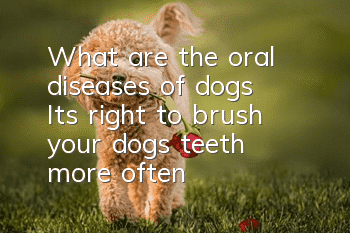What are the oral diseases of dogs? It’s right to brush your dog’s teeth more often!

Symptoms of dental calculus in dogs
Salivation, bad breath, light yellow to yellowish brown calculus on the side walls of the teeth, most of them are accompanied by gingival inflammation, and in severe cases, they will be reluctant to eat or eat. Pain
The dangers of dental calculus
With the attachment of bacteria and long-term stimulation of dental calculus, dental calculus can cause inflammation of the gums, causing edema and congestion of the tissues around the teeth, causing gingivitis and even periodontitis< br />
Gingivitis in dogs
Gingivitis is the predecessor of periodontal disease. The place where the gums and teeth meet is called the gingival sulcus. Because dogs do not know how to clean their teeth, after eating for a long time and many times, a lot of food residue accumulates in their gums, causing a large number of bacteria to grow here. When bacteria invade the gums, they will inflame the gums and cause pain.
Periodontitis in dogs
Periodontitis is one of the most common diseases of pet dogs in the world. If the owner does not take care of the teeth of his dog on weekdays, the dog’s teeth will become damaged over time. Dental calculus will develop. If left alone and not treated, the accumulation of dental calculus will cause periodontal disease. Periodontal disease will cause tooth root redness, inflammation, bleeding and bone loss in the alveolar bone. In severe cases, it will destroy the teeth. Periodontal ligament causes loosening of teeth and recession of gums, which will eventually lead to massive tooth loss. Finally, bacteria will enter the dental pulp, and the bacteria will spread through the blood to various organs of the body, such as blood vessels, heart, lungs, liver, kidneys, etc., causing complications. . Therefore, periodontal disease is a very serious dental disease. If you find that your dog has periodontal disease, you should take it to the hospital for treatment in time
Dog tooth decay
Dogs also suffer from tooth decay. The reason for tooth decay is that food residue remains in the mouth, and then bacteria use the food residue as nutrients to continue to breed. When multiplying, An acidic substance will be produced. When this substance comes into contact with the teeth, it will slowly dissolve the calcium in the teeth and form tooth decay. Tooth decay can cause pain in the dog's gums, tooth necrosis, and a significant loss of appetite.
Precautions for misaligned teeth/double rows of teeth: The cause of misaligned teeth is generally developmental problems. If you have such problems, it will be easier to retain food residues, and gingivitis or even gingivitis will appear earlier and more seriously. Periodontal disease.
Daily care suggestions
You should pay more attention to oral hygiene, brush your teeth once a day, develop the habit of brushing your teeth from an early age, and use oral cleansers regularly to reduce the adhesion of dental plaque. Feed more rough food, such as dog food, reduce the amount of sticky and soft food, and often give your dog teeth cleaning sticks, dog chews, etc. of appropriate hardness to exercise your dog's teeth. Orally taking one piece of dental plaque every day can effectively prevent the formation of dental plaque.
- Pimples on dogs
- What should I do if my dog doesn’t want to take a bath?
- How to train a Poodle to stand and walk? Common training methods for Poodles!
- How to save your dog from canine distemper
- Can’t you train a Husky? Husky training tips!
- What causes swollen dog paws?
- Dog hepatitis symptoms and prevention measures
- What is canine distemper? Symptoms and treatment of canine distemper in dogs!
- Things to note when raising a French bulldog
- What preparations do owners need to make before fostering a dog? Things to note when fostering a dog!



